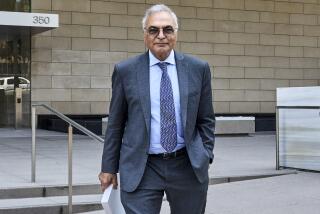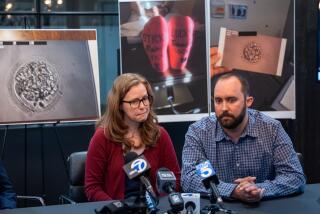Anatomy of a Lawsuit
Jon P. Stucky struggles with a wish to die. He said he has been in agonizing pain since he received a spinal implant in 1988 and often dreams of “going home, going to heaven.”
The 40-year-old San Dimas man has joined more than 5,000 other back pain sufferers nationwide in a new wave of lawsuits that will soon be filtering into courtrooms in Los Angeles and elsewhere.
They have filed lawsuits against the manufacturers of spinal implants, which the plaintiffs hoped would ease their back problems, and the surgeons who installed them. Instead, the plaintiffs say they were misled and in many cases left worse off by the surgery.
The spinal implant litigation, spawned a few years ago by a report on the ABC News program “20/20,” is moving onto trial calendars. The first trial in California ended this month with a victory for the defense, and cases are pending for hundreds of other Californians.
The implants involved pedicle screws, stainless steel devices that are screwed into the spine to hold injured bones immobile until they fuse together naturally.
Stucky, who had the implant inserted after an earlier back surgery failed to ease his pain, is now bent forward, suffering in a way that he says makes his ordeal before the implant seem “like a toothache.”
“If I wasn’t living it,” said the former construction worker, “I would say it is unbearable.”
At the heart of the cases is the contention that patients were not informed that the screws were considered experimental for use in the pedicles, a part of each vertebrae located alongside both sides of the spinal cord. The manufacturers are named because they allegedly promoted the screws for uses not approved by the Food and Drug Administration.
The two-inch screws are part of a kit, like scaffolding, that keeps the spine immobile while the bones grow together. Stucky, who suffered a herniated disc 14 years ago at his construction job, said the device in his back, as shown in an X-ray, looks like the Eiffel Tower.
The implants include metal plates or rods and nuts. They are used in place of a body cast, other kinds of hardware or complete immobilization. One physician compared the implants to a “very elegant Erector set.”
Thousands of these devices have been put into backs to stabilize the spine after surgery for a wide variety of ailments, ranging from fractures to degenerative diseases. The most common complaint by the litigants is severe pain when they had been expecting relief.
In 1993, the Food and Drug Administration threatened action against manufacturers for advertising the screws for the spine when they had been cleared only for other purposes, such as repairing long bones in the arms or legs. The FDA’s safety concerns stem in part from the pedicles’ proximity to the spinal cord and nerve roots.
But physicians, who are not regulated by the FDA, generally support the continued use of the screws in the pedicles--a practice that defense lawyers refer to as “off-label” usage--and the manufacturers eventually won clearance to promote the screws for specific ailments, including trauma, tumors or fractures in the spine’s lower lumbar region.
Dr. Bruce Burlington, FDA director of the Center for Devices and Radiological Health, said implanting the screws is “technically tricky.” If done incorrectly, the screws can impinge on a nerve, cause spinal fluid leakage, tear a blood vessel or break the pedicle.
“It’s like putting a 2 1/2-inch wood screw through something the size of a piece of chalk,” he said. Once in place, the screws also can break, causing more injury and pain for the patient.
About 10 manufacturers and distributors have been the target of lawsuits, and lawyers for the firms and plaintiffs are working together to handle the onslaught. Many of the lawyers working on the pedicle screw litigation previously handled lawsuits over breast implants or the hormone DES.
So far, there have been two trial victories for manufacturers and one for a plaintiff.
“The plaintiffs are talking $15 million or more from each manufacturer, but at this point no one is willing to offer money for anything,” said Raymond Pajares, a New Orleans-based lawyer representing one of the distributors, Advanced Spine Fixation Systems of Cypress. Advanced Spine won the recent case in San Francisco.
An elderly woman in that case had sued after part of her vertebrae cracked where the screw had been inserted. Defense attorneys contended that she fell, causing the injury, but her lawyer said there was no evidence of such a fall. She will seek a new trial.
“It is our position from our client,” Pajares said, “that we will try every case. We have no intention of having a breast implant situation occur.”
After tens of thousands of women reported trouble with breast implants, a rash of lawsuits were filed against manufacturers. The litigation led to a $4.25-billion settlement that eventually collapsed when one of the major manufacturers went bankrupt. A revised, smaller settlement is pending.
In the spinal implant cases, the plaintiffs’ claims are complicated by the fact that many of the litigants had pain before the implants. Plaintiffs’ lawyers also say they have trouble finding orthopedic surgeons willing to testify against their colleagues, who also have been named as defendants in some of the lawsuits.
“It’s just that some people don’t get better,” said Stephen Phillips, a Philadelphia lawyer who represents a manufacturer defense council. The pain after the implants may result from “the natural progression of the disease or the failure of the fusion to occur for biological reasons.”
But plaintiffs’ lawyers maintain that many of these spinal devices were used in patients unnecessarily. “In a lot of my cases, the surgery wasn’t even necessary, let alone the instrumentation,” said Gregory Ramirez, an Oxnard plaintiffs’ lawyer.
Some physicians learned how to insert the devices at weekend retreats sponsored by manufacturers at resorts, he said. Others received compensation from manufacturers to conduct trials on patients but never informed the patients that they were part of a trial or that the physicians had a financial interest in the device, Ramirez said.
Beverly Hills lawyer David E. Lewis, who also is representing some of the plaintiffs, described a client who must walk around with a cane during office visits because sitting is too painful.
“Every few minutes he winces and sometimes shrieks out because of the pain,” Lewis said.
But San Francisco defense lawyer Robert S. Niemann dismisses some of the charges as “just plaintiff talk.” He said his client, Advanced Spine, sold the spinal devices only to top-notch surgeons. They learned how to apply them over many months of training at hospitals and universities, he said.
Dr. Vert Mooney, a professor of orthopedic surgery at UC San Diego, conceded that some of the litigants’ injuries may stem from the application of the screws.
“Properly applied, these pedicle screws do an excellent job,” said Mooney, who has been hired as an expert witness by manufacturers. “Now sometimes things go wrong and in a particular individual that may happen. But to blame the screws is crazy.”
The FDA has proposed a rule that, if approved in its current form, would allow manufacturers to promote the screws for more uses in the spine while still withholding clearance for a majority of its current applications, said the FDA’s Burlington.
Stucky’s lawyer attributes his client’s torment to scar tissue caused by the screws. The defense lawyer handling the lawsuit could not be reached for comment, but an attorney who is coordinating the defense nationally for the manufacturer of Stucky’s device, AcroMed Corp., said Stucky’s prior back surgery indicates that he had severe pain before the implants.
For Stucky, the litigation is a vehicle for expressing his anger about being used as what he called a “guinea pig.” He can no longer work, he said.
“Life is a hobby for me--making it through it,” said Stucky, who is married and has a teenage daughter. “I wake up in agony and feel like I am going to die every night.”
More to Read
Inside the business of entertainment
The Wide Shot brings you news, analysis and insights on everything from streaming wars to production — and what it all means for the future.
You may occasionally receive promotional content from the Los Angeles Times.











